-

Meta Quest 2
Best (and still most affordable) VR headset
$350 at Best Buy
-

HP Reverb G2
Highest-resolution PC VR headset
$599 at HP
-

Valve Index
One of the best Steam VR hardware options
$999 at Steam
-

Sony PlayStation VR
Best bet: wait for PSVR 2 on PS5
$200 at Best Buy
![]()
VR still isn’t an essential experience for anyone, but it can be a lot of fun and surprisingly useful at times. The hardware, however, is currently in transition. Sony’s $550 PSVR 2, which requires a PlayStation 5, arrives Feb. 22 but is available for preorder. There’s been a wave of new VR headsets lately, including the $1,500 Meta Quest Pro and the not-available-in-the-US Pico 4. Apple’s rumored headset should be on its way this year, along with the Quest 3. And yet, right now, the Meta Quest 2 is still by far the best choice.
The cost of a new VR headset might be going up these days, and the $400 Quest 2 jumped up in 2022. Even so, it still offers a completely wireless experience, with access to a great library of fantastic games like Resident Evil 4 and The Walking Dead: Saints & Sinners. It can also be connected to a PC to play titles like Half-Life: Alyx, or run a variety of PC VR applications. Meta keeps improving its software over time with added extras.
Anyone in the VR/AR industry looking to explore next-gen face tracking or mixed reality might consider the Quest Pro, but its high price means it won’t make sense for anyone else right now. Keep in mind, Meta is releasing the Quest 3 this year, at a price expected to be similar to the Quest 2 and possibly with some features that are on the Quest Pro. (The Pico 4 gives some hints of how the Quest 3 could be upgraded.) You might want to wait for it, or for the other VR headsets on the horizon.
Apple is expected to have some form of advanced VR/AR headset next year that could also be super expensive. Sony’s PlayStation VR 2, also coming in 2023, requires a PlayStation 5 but has fantastic new controllers and could boast unique games. And in the meantime, we may see more experimental, phone-connected headsets like the HTC Vive Flow start to pop up.
VR remains an impressive but still limited proposition. Thanks to tremendous advancements in the visuals, tracking and overall performance of VR hardware, the best VR headset options have become more realistic and immersive. More advanced metaverse platforms and social worlds have given VR owners more to explore, too. Even so, VR still hasn’t become a necessary product for most people.
VR’s strongest applications tend to be gaming and fitness. For fitness, a standalone headset like the Quest 2 is practically mandatory, to avoid wire tangles and make sure you can move around. (The Quest 2 also has a fitness tracker app and syncs with Apple Health.)

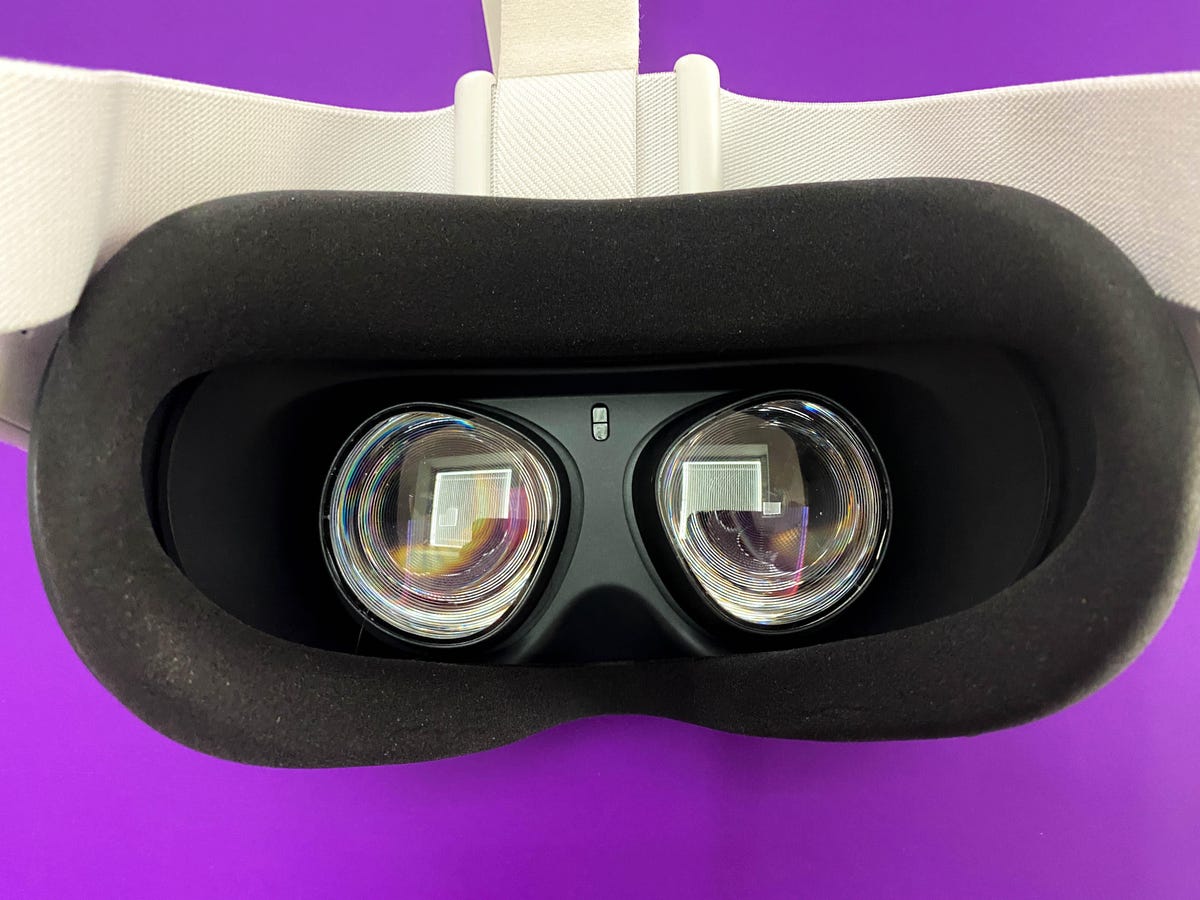
The Quest 2 is still the best VR headset right now, but more headsets are expected soon.
Scott Stein/CNET
Will you want a headset that works with your phone? Qualcomm’s been making headway on a wave of VR and AR headsets that plug right into phones, but at the moment the software for these devices is a work in progress. Neither Google nor Apple really supports VR at a seamless system level for phones yet, meaning devices have to figure out awkward solutions.
If you’re a PC gamer, a PC-connected VR headset still offers the most versatile collection of software for an immersive VR experience, and also lets you use that headset for creative and business tools. Note that a more powerful VR system will still be largely tethered to a desktop or laptop and may require external sensors.
And what about console gaming? The aging PlayStation VR
still exists, but you’re better off waiting for the PSVR 2 if you have a PS5.
We update this best VR headset list periodically, but note that prices are subject to change.

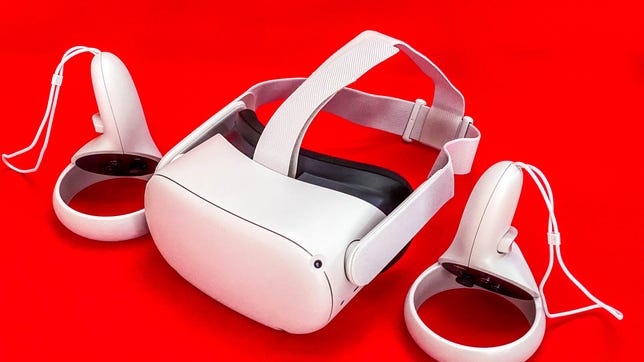
Sarah Tew/CNET
Meta Quest 2
Best (and still most affordable) VR headset
Good: Self-contained and wireless; great touch controllers; comfortable design for gaming; doubles as PC VR headset; plenty of apps
Bad: More expensive
The Quest 2 used to be $299, but a surprise price bump to $400 (or $500 for the version with more storage) has made Meta’s 2-year-old, self-contained VR headset even more expensive. But even with the increased price, the Quest 2 remains the best and most versatile VR headset of the moment. It’s also, considering it requires no gaming console, phone or PC, the most affordable.
The $1,500 Quest Pro offers upgrades on the display, controllers, and adds features like better mixed reality and eye/face tracking, but its value for everyday VR explorers isn’t worth the extreme cost. The Quest 2 remains the recommended pick until a Quest 3 arrives in 2023.
The base model’s 128GB of storage is plenty for storing dozens of games and apps, although keep in mind there’s no way to add more storage after purchase. Meta also now allows accounts to bypass Facebook logins, although a new Meta account is still required.
The Quest 2 reminds me of the Nintendo Switch for its versatility and fun, and it has a growing library of surprisingly effective fitness apps. The Quest 2 can also connect with a PC to run more advanced apps from Steam or Meta’s own app library, using a single USB-C cable or wirelessly.
$350 at Best Buy$400 at MetaYou’re receiving price alerts for Meta Quest 2 Resident Evil 4 bundle with Beat Saber 128 GB — Advanced All-In-One Virtual Reality Headset

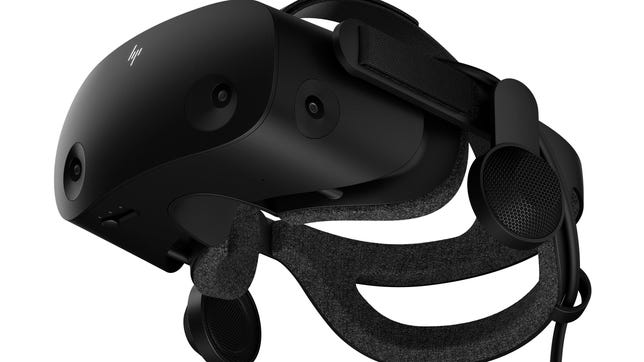
HP
HP Reverb G2
Highest-resolution PC VR headset
Good: Really sharp high-res display, great audio, comfortable design
Bad: Mediocre controllers
If your idea of the best VR headset is to have the best image quality in consumer VR, HP’s Reverb G2 wins. For serious gamers (or VR racing sim fans), it’s probably your best choice. The 2,160×2,160-per-eye resolution and 114-degree field of view are the best at this price range, and the lightweight, comfy headset also has fantastic dropdown speakers designed by Valve. It’s technically a Microsoft Windows mixed reality headset that prefers to launch into Microsoft’s native Windows 10 VR ecosystem, but it bridges with Steam VR and works with those games and apps, too. Built-in camera-based room-tracking is easier to set up than the Valve Index’s external base stations, but is more prone to tracking errors. The included controllers, based on Microsoft’s VR controller design, feel clunkier than either the Quest 2 controllers or the Valve Index controllers. Also, the over-ear speakers are your only audio choice; there’s no headphone jack.
It typically lists for $599, but it’s often been on sale for less.
Read our HP Reverb G2 review.
$599 at HP

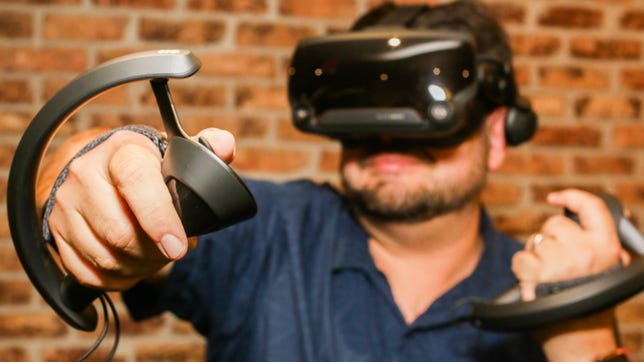
Sarah Tew/CNET
Valve Index
One of the best Steam VR hardware options
Good: Futuristic controllers; high-quality headset; works with Vive hardware
Bad: Expensive; requires room setup and tethering cable
Valve’s headset isn’t as cutting-edge as it was when it debuted in 2020, but its Steam VR and Vive hardware compatibility, its excellent audio and its fancy controllers still make it hardware worth considering. Valve’s “knuckle” controllers are pressure-sensitive and can track all five fingers, making them almost like gloves. Not all apps make the most of them, but Valve’s hardware is mix-and-match compatible with the HTC Vive, which also is built on the Steam VR platform. The Index headset has excellent audio and a sharp, wide-field-of-view display.
The Index works with external “lighthouse” boxes similar to the HTC Vive, meaning you need to set those up in a room first. It’s not as self-contained as the Quest 2 or HP Reverb G2, which can track the room with in-headset cameras. It’s also definitely not wireless, but if you already have some older HTC Vive hardware, you could add on parts of the Index to mix and match.
Read our Valve Index review.
$999 at Steam

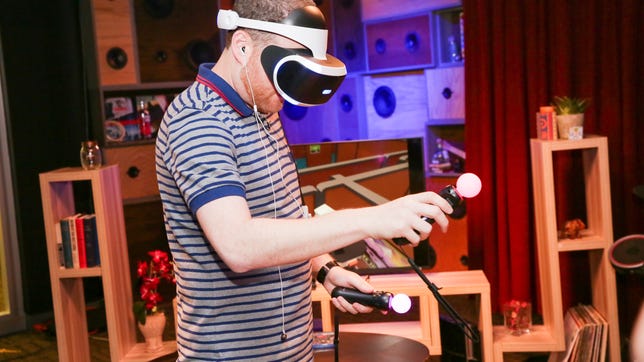
Sarah Tew/CNET
Sony PlayStation VR
Best bet: wait for PSVR 2 on PS5
Good: Plenty of games; lower price; works with many PS4 controllers like the DualShock and Move
Bad: Resolution isn’t cutting-edge; Sony hasn’t yet made great VR controllers that match the competition, but the PSVR 2 will bring plenty of upgrades
Sony’s aging PSVR headset is still the only head-mounted display for gaming consoles, and it still offers a surprisingly immersive experience. But with the PSVR 2 coming next month, if you have a PS5 you should absolutely wait. The PS5 works with the old PSVR, but it’s clunky and requires a breakout box full of wires to connect. It also needs outdated PlayStation Move controllers for some games, or your old PS4 controllers and camera, plus a camera adapter, to work.
The cost of the PSVR 2 may be more expensive, but its improved display, eye tracking, realistic haptic feedback, far easier setup and brand-new controllers mean you’d be silly not to wait.
Playing PSVR on a PS4 still holds up, although it’s so clunky to plug in that it may not be worth the effort anymore. It’s a shame, because there are many excellent virtual reality games, many of them exclusives (a few are listed here), and the PSVR 2 won’t support them all at launch. Note that this PlayStation VR headset is increasingly hard to get, and that may continue as Sony pivots to PSVR 2.
$200 at Best Buy
VR FAQs
Should I wait to buy a VR headset?
It’s not a bad idea. With PlayStation VR 2 and Apple’s mystery device expected next year, along with a possible Quest 3, there may be many devices on the way that are better than what’s here at the moment. VR is a technology that’s still in flux, with companies aiming for products that are smaller and more able to be connected to devices like phones. It’s probably best to spend as little as possible to avoid investing in outdated gear. The Quest 2 is still the best value and most complete headset even at its higher price, but as the Pico 4 indicates, competition is likely to increase.
What should I look for in a VR headset?
It depends, really, on whether you’re connecting to a PC or not… and whether you plan to do work with it. There are plenty of Windows-compatible headsets, but they vary in display resolution. Higher is better, and so is a larger field of view. Headsets can refresh at up to 120Hz now, and the faster they can refresh, the more natural and smooth VR movement feels. Most PC VR headsets have similar controller designs, and can bridge to work tools and apps. For portability or stand-alone comfort, the Quest 2 doesn’t have any competition right now. For gamers with a game console, the PlayStation VR is the only option, but you’ll probably want to wait for the PSVR 2 if you have a PS5. Also, consider the app libraries: The Quest has a lot of exclusive games, Windows-connected headsets have lots of compatibility with work apps and experimental tools, and Sony’s PlayStation library has unique VR games, too.
Do any of these headsets work with phones?
The old world of phone-based VR headsets — like the Samsung Gear VR and Google Daydream — are basically dead. A good number of the current iPhone, Android and VR app options don’t even work with the old mobile VR goggles. The Quest 2 does have a phone app for streaming content for a parent to monitor, and can receive phone notifications and sync some health data for workouts, but it’s still not fully integrated with phones. If smartphone-based VR comes back, it will more likely be in the form of small headsets that plug into phones via USB-C for VR content, VR gaming and other uses.
How do I care for my VR headset?
VR headsets can get dusty and grimy. Take extra care with the lenses, which should be cleaned gently with microfiber cloths the same way you’d treat glasses (don’t use liquids). It’s a good idea to invest in a silicone cover to protect the face plate from sweat and dirt, or look for extra face covers to swap out over time. It’s a very good idea to keep your headset covered when not in use. Take extra care not to expose your VR headset to bright sunlight: The sun can damage VR displays if beams hit the lenses of the headset. (To be safe, I keep mine in cases, or turn the lenses away from windows.)
More for gamers
- Best Gaming Laptop for 2023
- Best Gaming PCs for 2023
- Want to Play Half-Life: Alyx? Here’s the VR Gear That Works
